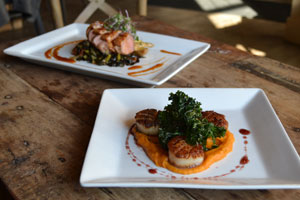The Perfect Turkey
Q. My Thanksgiving turkey is always dried out. How do I make sure it’s cooked all the way through while still getting a tender, juicy bird? — Tom, Greenville
A. When cooking any protein product, it will be at its peak of juiciness when it is raw. Hence, our job is to maintain as much of that moisture as possible. Two fundamentals that will aid in moisture retention are cooking at lower temperatures and adding moisture to the original product.
The lower the temperature that you roast your turkey, the juicier the finished product will be. I suggest trying to roast your turkey at 250° F. This is about as low a temperature as you can roast and still achieve the temperature of 165° F for safe poultry. The one drawback to low-temperature roasting is that caramelization does not occur readily at low temperatures, so your turkey will not brown as well. For this reason some cooks sear the outside of poultry and roasts at higher temperatures (like 400° F) and then finish them at lower temperatures.
To add moisture to your turkey, you can either brine it or inject it. I brine my turkeys under refrigeration for 3-5 days in a solution of 1/3 cup of salt and 1/3 cup of sugar per gallon of water. The osmosis process exchanges the natural juices of the turkey with the saltiness of the brine. The brine acts as both a moisturizer and a flavor enhancer. If you don’t have the time or the space to brine a turkey at a safe temperature, injecting is basically speed-brining. Simply inject as much brine or other marinade into the turkey prior to cooking.
Combining both brining and slow roasting makes great sense. Tom, feel free to try these suggestions and let me know how it turns out!










Leave a Comment